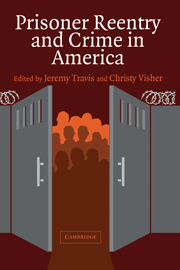Book contents
- Frontmatter
- Contents
- List of Contributors
- 1 INTRODUCTION
- 2 FROM CELL TO SOCIETY
- 3 REENTRY AS A TRANSIENT STATE BETWEEN LIBERTY AND RECOMMITMENT
- 4 THE CONTRIBUTION OF EX-PRISONERS TO CRIME RATES
- 5 DOES SUPERVISION MATTER?
- 6 THE IMPACT OF IMPRISONMENT ON THE DESISTANCE PROCESS
- 7 COMMUNITIES AND REENTRY
- 8 WORK AND FAMILY PERSPECTIVES ON REENTRY
- 9 CONSIDERING THE POLICY IMPLICATIONS
- Index
3 - REENTRY AS A TRANSIENT STATE BETWEEN LIBERTY AND RECOMMITMENT
Published online by Cambridge University Press: 05 June 2012
- Frontmatter
- Contents
- List of Contributors
- 1 INTRODUCTION
- 2 FROM CELL TO SOCIETY
- 3 REENTRY AS A TRANSIENT STATE BETWEEN LIBERTY AND RECOMMITMENT
- 4 THE CONTRIBUTION OF EX-PRISONERS TO CRIME RATES
- 5 DOES SUPERVISION MATTER?
- 6 THE IMPACT OF IMPRISONMENT ON THE DESISTANCE PROCESS
- 7 COMMUNITIES AND REENTRY
- 8 WORK AND FAMILY PERSPECTIVES ON REENTRY
- 9 CONSIDERING THE POLICY IMPLICATIONS
- Index
Summary
Introduction and Background
Between 1980 and 2001 the incarceration rate in state and federal prisons grew by nearly 240 percent. This growth far exceeded any growth in crime rates and diverged markedly from the trendless and stable pattern of incarceration that prevailed for the previous half-century. Growth in incarceration is attributable first to the 10-fold increase since 1980 in incarceration rates for drug offenses. Beyond drugs, no contribution to that increase is associated with increases in crime rate or increases in police effectiveness as measured by arrests per crime. Rather, the entire growth is attributable to sentencing broadly defined – roughly equally to increases in commitments to prison per arrest (an increase in prosecutorial effectiveness and judicial sanctioning) and to increases in time served in prison, including time served for parole violation. It is this last factor, the role of parole, involving both release from prison (reentry) and recommitment to prison, which provides the focus for this chapter. Indeed, reentry can be seen as an inherently transient state that individuals occupy for only a limited time, whereby a prisoner moves to either full liberty in the community or recommitment back to prison. Analysis of these flows and their impact on public safety are our major concern.
Prior to the mid-1970s, it was common for parole boards to have unchallenged authority to decide when an offender would be released from prison prior to the expiration of the offender's maximum sentence.
Information
- Type
- Chapter
- Information
- Prisoner Reentry and Crime in America , pp. 50 - 79Publisher: Cambridge University PressPrint publication year: 2005
Accessibility standard: Unknown
Why this information is here
This section outlines the accessibility features of this content - including support for screen readers, full keyboard navigation and high-contrast display options. This may not be relevant for you.Accessibility Information
- 51
- Cited by
